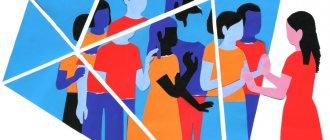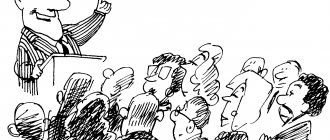They say that “The eyes are the mirror of the soul.” You can read through the eyes all the emotions a person experiences: joy, sadness, boredom, resentment, irritation, anger, etc.
The eyes are a window into his inner world, the key to understanding his inner essence. “Oh, eyes are a significant thing,” thought the dog Sharik in Mikhail Bulgakov’s “Heart of a Dog.” - “Like a barometer. Everything can be seen - who has great dryness in their souls, who can poke the toe of a boot into their ribs for no reason, and who is afraid of everyone.”
“Empty eyes are an empty soul,” said the famous director Konstantin Stanislavsky.
You can deceive with words, facial expressions, but not with your eyes. “When the eyes say one thing and the tongue another, the experienced man believes the former more,” wrote the American philosopher Ralph Emerson.
“Look into my eyes!” we say when we want to understand whether they are lying to us or telling the truth. - “I can see in your eyes that you’re lying!”
Rules for making eye contact without embarrassment
There is an opinion that the norm is 70% maintaining eye-to-eye contact. It is not without meaning. Many of us need to acquire the skill of looking our interlocutor in the face. At the same time, compliance with the measure is required here in the same way as in everything else. If you see that a person does not feel very comfortable under your gaze, do not put pressure on him. Redirect your attention to the other side, think at the same time.
And one more detail that characterizes a good interlocutor, which is even more important than time - the way you look. Calm or anxious? Is your gaze supportive or oppressive? If you have decided to learn to look at your interlocutor without taking your eyes away, avoid this mistake: do not try to look closely at the area of the so-called “third eye” or at the bridge of the nose. This technique puts pressure, and the opportunity to observe the face and facial expressions of the interlocutor is lost. And the very habit of staring with your eyes, unceremoniously staring at the faces of others is not the ability to maintain visual contact, but a manifestation of elementary bad manners.
Where should you look in this case? Unexpectedly, but exactly where a driver with experience behind the wheel of a car usually looks. He does not look at one point: nowhere and everywhere at the same time, that is, at the situation on the road as a whole. It is necessary to develop the habit of looking with an unfocused, wide gaze.
If your goal is not to put pressure on the interlocutor, you should not look at him closely. Unfocus your gaze, look not into the person’s eyes, but only in the direction of his face. Thus, there is a transition to peripheral perception, in which you are not distracted and can catch any unconscious micromovements of a person and his face. If the interlocutor is pleasant to you, your gaze will also radiate warmth.
The most effective exercises for concentration
Recommendations
- Share with your friends and loved ones what is bothering you. Unless, of course, they already know about your problem. By telling about your experiences to another person who is ready to listen and provide support, you legalize most of the tension that tends to accumulate, provoking the occurrence of various diseases. This is human psychology. Feelings have energy that, without finding a way out, has a destructive function, both for the body and for relationships with other people. It's like cooking soup with the lid tightly closed. Sooner or later it will be blown away, literally exploding, if you don’t periodically let off steam.
- Use the method of positive affirmations. These are positive statements that, influencing a person at the subconscious level, help get rid of complexes and fears. Changing his worldview, behavior style, reactions, and so on.
- Before going to bed, analyze the past day. What was interesting, or maybe sad, about it. What can you be proud of, what is worth paying attention to in the future. Just try to carry out this analysis without evaluatively, that is, without giving a general description. Moreover, without blaming yourself for failures. If you didn’t manage to meet your interlocutor’s gaze, note for yourself exactly what the difficulties were, what feelings and thoughts you encountered. Such an analysis will allow you to increase your level of awareness and identify patterns in behavior, which will subsequently make it easier to work on your own limitations.
- Practice meditation. It will help not only achieve a sense of inner harmony, but also increase the level of awareness. Because the whole process a person is concentrated on his feelings, he notices thoughts, not driving them away, but simply watching how they appear and disappear. This approach is effective, especially when you need to make a decision, figure out how to deal with a problem, and so on. By relaxing the body and brain - insight, that is, insight, happens on its own.
Causes of fear
Being afraid to look people in the eyes - this problem has a name. Ommatophobia is the fear of looking into the eyes. A fairly rare mental disorder in which an ommatophobe is not just afraid to look into the eyes, he even experiences horror. But more often the cause of fear is not a phobia, but simpler reasons. Let's look at several reasons why a person avoids eye contact.
Lie. One of the assumptions why a person avoids direct gaze is an attempt to hide some information.
Perhaps he does not want the other person to understand his true emotions or intentions. If a person tries to lie, in addition to avoiding eye contact, they may exhibit the following signs:
- avoiding the topic of conversation, being distracted by unnecessary details;
- change in skin tone: pallor or redness;
- touching the nose or lips;
- body tension - posture, face;
- high speed or slurred, unclear speech.
But it is worth noting that the probability of lying with such behavior cannot be 100%. A person may simply not want to go into any details. For example, he wants to hide his negative attitude - disapproval, envy, indifference.
Low self-esteem . A shy, insecure person may also look away in dialogue. When communicating, such people tend to be afraid to say or do something wrong. Perhaps he has some feelings for his interlocutor. This can cause severe embarrassment, especially if your cheeks turn red. Or a person has experienced some kind of psychological trauma, as a result of which, when getting close to people, he begins to hide his experiences.
Lack of mood. Also, a participant in a dialogue may have some personal reasons for a bad mood that do not depend on the topic of the conversation or the current situation. One can also assume an attempt to hide the attitude towards the interlocutor - for example, irritation. Anger can be identified by constricted pupils.
Uninteresting topic. Avoidance of direct gaze may be due to conversation fatigue. Perhaps the topic of conversation is uninteresting or unpleasant. In this case, the flow of unnecessary information becomes too large, the person gets tired of it and switches attention to his thoughts. Therefore, he will not look at his interlocutor.
Why is it necessary to look into the eyes?
Continuous eye contact is an animal instinct that has been preserved in humans through the process of evolution. Animals have a continuous gaze directly into the eyes - a sign of aggression and conflict between individuals. It’s enough to imagine a picture of two cats in the spring, looking at each other, ready to pounce on their opponent with their claws. And the cat who is the first to give up and look away will be the loser in the fight.
In humans, eye contact has become one of the indispensable methods of non-verbal communication and a tool for determining the character, temperament and mood of the interlocutor. Continuous gaze into the eyes of the person opposite can be both a way to conquer and embarrass the girl you like, and to control the actions of your opponent in a conflict situation.
For many, constantly looking into the eyes is unbearably difficult: embarrassment begins, the nervous system gets excited, and in some situations, you just want to run away to get away from a stressful situation for yourself. The ability not to look away at the wrong moment is one of the keys for strong mentally individuals, as well as for training communication skills.
Eye contact without embarrassment and confidence between a guy and a girl
Mastering the skill of maintaining eye contact is an important part of pickup.
If a girl, when meeting a guy, sees his gaze downcast or darting around, she will immediately feel his insecurity. Moreover, this can give rise to thoughts about unclean intentions. It’s better for the woman to look away first.
Why is it so important to maintain eye contact when meeting people? Why do pickup artists from all countries use this technique? The thing is that a confident male gaze can evoke strong emotions in a woman, often reminiscent of falling in love. This is explained quite simply: if a man looks straight and openly, then he belongs to the category of courageous, strong “males”. And the girl’s subconscious quickly reads this. If suddenly a young man begins to look away while talking to a girl, this raises doubts and does not characterize him from the best side. Confidence shines through in the behavior and look of a real male; he does as he wants, without fear of anything. Especially if it’s the look of a stranger you like.
Maintaining a confident gaze is difficult, but you can learn it
Behind the insecure glances of those who avoid eye contact, complexes are hidden. There may be a lot of them. For example, psychological problems, parenting, something that affected self-confidence.
Step-by-step instructions for men and women on where to start self-development and self-improvement
How to learn to hold your gaze when communicating with your interlocutor?
How to stop being afraid to look people in the eyes, including when talking? There are a number of exercises by doing which you can learn to look straight into the eyes of your interlocutor and not hide your gaze. They help improve your peripheral vision and make your gaze more piercing.
When performing them, it is also recommended to observe the measure. Do not overdo it! If you experience dizziness or watery eyes, you should stop exercising. You can resume training the next day.
Exercises
For eye muscles
It consists of strengthening the muscles of the eyeball. To do this, you will need a simple sheet of paper, in the middle of which we draw a dot.
- We place the sheet in front of us, maintaining a distance of 1.5-2 meters. We look closely at the point for about 2-3 minutes, without being distracted. When we manage to focus, we make slow circular movements with our heads. We start with a small radius, gradually increasing the amplitude. If you imagine the movement of the head schematically, it will look like a cross-section of a spiral or the pattern of a snail shell. Continue the exercise for 10 minutes.
- Then for another 10 minutes we make head movements in any form and at different speeds. At the same time, we maintain our gaze at a given point.
If you feel that it is becoming difficult to maintain focus, you can take a short break and return to the exercise in a few minutes.
For concentration
This is a concentration workout that helps reduce the number of blinks.
- We take the same sheet of paper and hold it in front of us. We look at the point in time as much as possible.
- After this, you need to close your eyes. Then, without changing the position of the head, we raise the pupils to the ceiling and look at any point for about 5 minutes. At the same time, we try to blink as little as possible.
- Next, in the same way, without blinking, we concentrate our gaze on the point on the floor.
To hold your gaze
It develops the ability to not look away for a long time. To perform this you will need a mirror.
- Let's get comfortable. We direct our gaze to the reflection in the mirror, concentrating on the bridge of the nose. We don't blink. The recommended time for this block is 15 minutes.
- Then, for the same amount of time, we look alternately, first into the pupil of the left eye, then of the right.
- In the final part of the exercise, it is necessary to practice the skill of expressing emotions only with the eyes, without the help of facial expressions. This helps you gain the ability to manage your reactions during a conversation.
Exercise is just a basic part of training for every person. To work through self-doubt and low self-esteem, additional sessions with a psychologist are necessary.
How to improve diction and speech clarity at home
You can acquire the skill of maintaining eye contact through diligent, but far from hard work. By working on yourself in this direction, you can become the owner of a strong and piercing gaze, which is so necessary for a person’s social success.
Scientists' conclusions
Although these two actions seem independent, people often look away from the other person during a conversation. Thus, scientists assume that both of these processes are connected. The effect was more pronounced when people tried to find a verb that went with less common nouns, so it follows that this activity uses the same parts of the brain as eye contact. The results show that in such situations, the brain, to avoid overload, breaks eye contact and concentrates on solving a word problem.
Found a violation? Report content










